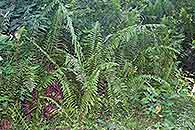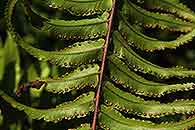Nephrolepis biserrata (Sw.) Schott
Synonyms |
Aspidium biserratum Sw. |
|---|---|
Common name |
|
Description |
Rhizome short, erect, with long stolons, not producing tubers. Fronds tufted, suberect to arching, up to 4 m long. Stipe up to 75 cm long, light brown, shiny, with narrowly lanceolate, light brown scales up to 2 mm long at the base, glabrous with age. Lamina up to 3.25 × 0.5 m, narrowly elliptic to linear oblong-lanceolate in outline, pinnate, lower pinnae slightly reduced. Pinnae 8-25 x 1.4-2.9 cm, shortly petiolate, narrowly oblong in outline, base oblique and broadly cuneate, unequal, apex tapering to a point, both surfaces thinly set with minute white hairs when young, hairless with age, margins shallowly serrate (more strongly at the apex), the serrations often occuring in pairs, veins free, ending in an inconspicuous hydathode. Rhachis pale brown, thinly set with small white hairs and scattered pale brown scales. Sori round, c. 1.5 mm in diameter, set in a submarginal line along both sides of the pinnae; indusia facing the margin, kidney-shaped, membranous, entire. |
Notes | The large size separates N. biserrata from similar Nephrolepis species. |
Derivation | biserrata: doubly serrate, referring to the serrations of the pinnae. |
Habitat | In swampy ground and permanently moist conditions, occuring in coastal swamp or dune forest and low-altitude evergreen, riverine forest, bushland clearing and thickets. |
Distribution worldwide | Pantropical distribution. |
Distribution in Africa |
Angola, Benin, Burkina Fasso, Cameroon, Central African Republic, Congo, Dem. Republic of Congo, Equatorial Guinea (incl. Bioko), Gabon, Gambia, Ghana, Guinea, Ivory Coast, Kenya, Liberia, Malawi, Mozambique, Nigeria, Senegal, Sierra Leone, South Africa, Sudan and South Sudan, Tanzania , Togo, Uganda, Zambia, Zimbabwe. |
Growth form |
Epiphytic, terrestrial. |
Literature |
|




